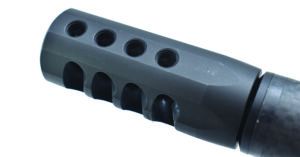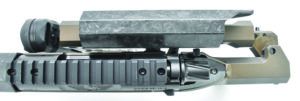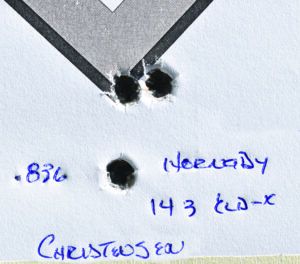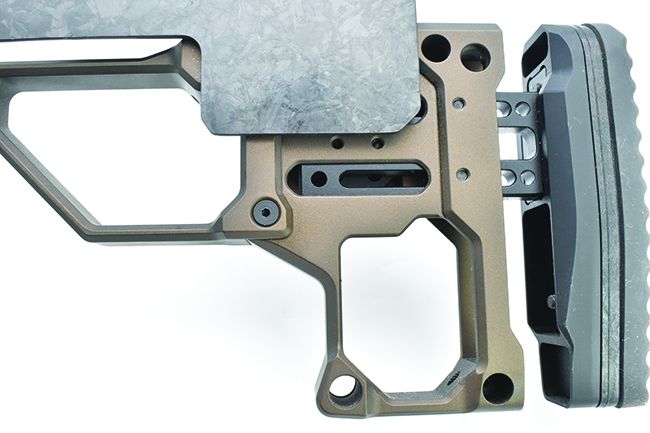The 6.5 PRC (Precision Rifle Cartridge) was designed by George Gardner of GA Precision and finalized and formalized by Hornady and then introduced at the 2018 SHOT Show. It is essentially a “magnumized” 6.5 Creedmoor (CM), using heavy-for-caliber, high-ballistic-coefficient bullets that require fast-twist barrels. Also like the 6.5 CM, the 6.5 PRC mandates short, fat cartridge cases along with very tight tolerances throughout the chamber. The result, like with the Creedmoor, is an accurate long-range-capable cartridge without a ton of recoil. Industry reports tell us that the 6.5 PRC is one of the fastest-growing cartridges in the long-range and hunting segments of the rifle world. Also, this is one of the cartridges you have searched for most frequently in our archives, so we thought this report was an absolute must.
Rifles capable of long-range shooting can quickly find themselves too heavy to carry in the field. We have also discovered that, as we age, we increasingly dislike weight and recoil in our rifles, so we set out to find up-to-date rifles chambered in 6.5 PRC that won’t tweak our backs or dislocate our shoulders. Our pocketbooks might be strained, however, because light and powerful can also be expensive, and because of the carbon-fiber-wrapped barrels on these rifles, the price tags are up there.
The first sample we chose was a Christensen Arms MPR (Modern Precision Rifle) $2400. As mentioned, the MPR sports a carbon-fiber-wrapped barrel designed to keep the tube as light weight, stiff, and cool as possible. The fore end and cheek piece are also carbon fiber and are mounted to a sculpted aluminum chassis.
Our first look at a Christensen Arms MPR came in the April 2021 issue where we examined it against long-range PRS-style rifles. And it almost won. The rifles in that comparison were chambered in 6mm Creedmoor. Here, we went to a heavier chambering and a lighter rifle. The 6.5 PRC is all about ballistics and down range energy. Where our 6 CM reloads pushed 2975 fps with a 109-grain bullet, and 6.5 Creed rounds are more in the 2700 fps range with 140-grain bullets, our 6.5 PRC loads were in the 2875 fps range with a 156-grain bullet. That launches a bullet with almost 2900 foot-pounds of energy at the muzzle and supersonic flight to about 1650 yards. That gives the hunter elk-worthy energy (at least 1500 foot-pounds) beyond 1600 yards. Please remember that just because you can shoot at extended ranges does not mean you should at extended ranges.
The second test rifle was a fully adjustable Springfield Armory Waypoint 2020, $2400. Using a carbon-fiber stock from AG Composites in the Evergreen camo pattern, the Waypoint offers a more conventional camo pattern for the stock, which some shooters will prefer.
Next came the brand-new Bergara MgLite rifle, $3000. Also a chassis-mounted system, the Bergara brings a minimalist design to the game.

We were expecting a great deal from these rifles, and to get the most from them, we needed a top-shelf optic. So we secured a Leupold Mark 5HD 3.6-18×44, a first-focal-plane scope equipped with the TMR reticle. At 26 ounces, the Mark 5HD is not super light, nor is it a monster to hump up a hill. The 3.6- to 18-power magnification gives us plenty of coverage for the field, and the 44mm objective is one of our favorite diameters — not so large that it has to be mounted with extra-tall rings, while still wide enough to get sufficient light to our eyes. At less than 12 inches in length, this Leupold packs a lot of features into a short tube that looks and works right on short or long rifles. We used Leupold 35mm rings to attach the glass to Picatinny rails on the rifles.
All three barrels have 1:8-inch twists, suitable for longer projectiles. Most of the factory ammunition we’ve seen has been in the 130- to 147-grain weight range. Velocities more than 3000 fps are possible, but we felt this cartridge could do better. We started experimenting with Berger 153- and 156-grain bullets more than two years ago and have been very pleased with the results on multiple 6.5 PRC platforms. We thought that would be the thing to do here as well. The Berger 153.5-grain Long Range Hybrid Target and 156-grain EOL Elite Hunter both did very well when pushed by near-maximum charges of VihtaVuori N565, N560, and Hodgdon H1000 powders. We lit the charges with CCI BR2 Large Rifle Benchrest primers. We assembled loads on Redding match dies. We finally admitted that we were tired of doing tons of case trimming with arthritic hands and bought a Henderson Precision power case trimmer. The trimmer and a few extras cost us about $900, including the motor, but then allowed us to do in minutes what used to take us days. Very easy to use, and we don’t think that we have ever seen a smoother or more precise chamfer on our trimmed cases.
Here’s how these bolt actions performed:
Gun Tests Grade: A
$2400
Christensen Arms produces a match-grade hand-lapped stainless-steel barrel and then wraps it in carbon fiber. On the MPR, the result is a stiff, lightweight, accurate tube. The finished product was about 0.920 inch just before the 5⁄8×24 threads and attached muzzle brake. In our tests, as verified with an infrared thermometer, the carbon-fiber-wrapped barrels on these rifles consistently heated up more slowly and cooled down more quickly than their all-steel brethren.
| Action Type | Bolt |
| Overall Length | Adjustable, 44.5 in.+ |
| Barrel Length/Twist | 24 in., 1:8 |
| Overall Height w/o Scope Mount | 6.75 in. |
| Weight Unloaded | 7.9 lbs. |
| Weight Loaded | 8.4 lbs. |
| Sight Radius | NA |
| Action Finish | Brown Cerakote |
| Barrel Finish | Black Nitride |
| Magazine Capacity | 3 |
| Magazine Type | Detachable box, AICS pattern |
| Stock | Aluminum Chassis |
| Drop at Comb | Adjustable |
| Drop at Heel | 0.25 |
| Bedding | V-Block |
| Buttplate | Limbsaver, soft rubber |
| Length of Pull | 12.5 to 14.5 in. |
| Receiver Scope-Base Pattern | Remington 700 |
| Trigger Pull Weight | 1.5 lbs. |
| Safety | 2-position rocker |
| Warranty | Limited, w/Accuracy Guarantee |
| Telephone | (435) 528-7999 |
| Website | ChristensenArms.com |
| Made In | U.S. |
Weight for the shorter-barreled versions of this model can start as light a 6.9 pounds. Our MPR, with the 24-inch 6.5 PRC barrel, came to us weighing in at 7.9 pounds. Not exactly in the New Ultra-Light Arms class of rifles, the MPR brings enough weight to keep a high-energy bullet from being uncomfortable to shoot for an extended session — the muzzle brake also helps. The MPR utilizes a proprietary brake that sports four bilateral ports. Recoil (maybe more noise) was noticeable, but certainly not unpleasant. Subjectively, we graded it in the 243 Winchester range. The brake also has four ports on the top that arrived plugged with Allen screws.
Moving from the rear forward, we removed each screw and then shot a few rounds. We didn’t think the rearward recoil lessened as we did so, but muzzle flip became much more subdued. So, with a 12-port brake on the rifle, we continued our shooting tests.

The chassis is made from 7075 aluminum billet and then hardcoat-anodized to a desert brown color. Black and tungsten colorings are also available. The action mates to the chassis using Christensen’s V-Block bedding. The action stayed tight and shot consistently good groups with most loads. The shooter gets six QD mounts at various locations on the rear of the chassis. When we wanted to put one up front, we found we needed to buy a QD port suitable for M-Lok rails and attach it to the 17-inch-long handguard. We would prefer to see a couple designed into the fore end on future models.
The fore end is solidly attached to the chassis and brings some new technology to the current version. Christensen Arms recently introduced the FFT or Flash Forged Technology. Stronger and lighter than the carbon fiber previously used, the FFT material is sufficient for use as a monocoque shell for many of Christensen’s new traditional stocks. Cheaper than titanium, it is also very enviro-friendly. If a mistake is made in the molding of these new FFT parts, the blemished part can be chopped up and dumped back into the solution for a second try. Note that the adjustable cheek piece is made from the same material. A portion of Picatinny rail is included on the 6 o’clock portion of the fore end and more slots are molded into the 3 and 9 o’clock positions. The bottom is flat, which makes it great for resting on bags. While wide enough to sit well, it is narrow enough to carry well by hand. A good lock, a strong magnetic latch, and a tight hinge allow the chassis to be shot while extended or folded to the right, making the MPR short enough to be carried in a proper backpack.

Other provided features include an adjustable length of pull, a standard AR-style grip and AICS compatible mags. Our three-round mag was made by Accurate Mags (AccurateMag.com) and marked “300 WSM” — a cartridge that has the same base dimensions as the 6.5 PRC. Additional three- and seven-round mags are available from Accurate Mags as well as MDT (MDTTac.com/magazines/). The mag has a large-lever tactical release that is easily found and operated.
The rear base of the chassis is set up for the addition of a monopod, if so desired. The action is designed with a Remington 700 pattern so scope mounts and many other aftermarket parts will fit. The rifle is topped by a 20-minute-of-angle rail. The bolt body, bolt handle, and bolt knob have been skeletonized or fluted to save weight, then finished with a black-nitride process.
Our Team Said: A bit rough in the beginning, the bolt throw smoothed out nicely. Function was perfect whether we were going from the magazine or single feeding. Overall average group size was just over 0.71 inch — and that is with this rifle not liking the Hornady 143 ELD-X at all. But the Norma 143s averaged less than 0.6 inch per three-shot group, and the Berger handloads using 156-grain hunting bullets shot sub-half-inch average groups. They also posted the best group of the tests at 0.336 inch. Add in a Trigger Tech flat-faced trigger that activated consistently with 1.5 pounds of pressure and a short and crisp break, and we loved this rifle.
6.5 PRC Range Data
| Norma Golden Target 143-grain Match | Bergara MgLite | Christensen MPR | Springfield Waypoint |
|---|---|---|---|
| Average Velocity | 2822 fps | 2892 fps | 2844 fps |
| Muzzle Energy | 2527 ft.-lbs. | 2656 ft.-lbs. | 2569 ft.-lbs. |
| Best Group | 0.610 in. | 0.518 in. | 0.620 in. |
| Average Group | 0.679 in. | 0.580 in. | 0.743 in. |
| Hornady Precision Hunter 143-grain ELD-X | Bergara MgLite | Christensen MPR | Springfield Waypoint |
| Average Velocity | 2908 fps | 3032 fps | 2925 fps |
| Muzzle Energy | 2686 ft.-lbs. | 2919 ft.-lbs. | 2717 ft.-lbs. |
| Best Group | 0.509 in. | 0.836 in. | 0.356 in. |
| Average Group | 0.568 in. | 1.080 in. | 0.574 in. |
| Berger Handloads 156-grain EOL | Bergara MgLite | Christensen MPR | Springfield Waypoint |
| Average Velocity | 2752 fps | 2865 fps | 2804 fps |
| Muzzle Energy | 2625 ft.-lbs. | 2845 ft.-lbs. | 2724 ft.-lbs. |
| Best Group | 0.631 in. | 0.336 in. | 0.691 in. |
| Average Group | 0.770 in. | 0.480 in. | 0.766 in. |
How We Tested: We fired the rifles side by side at American Shooting Centers in Houston, putting multiple three-shot groups downrange at 100 yards. While the ammo drought is not quite as severe as it once was, 6.5 PRC ammo is harder to find than 6.5 Creedmoor. That led us to checking out some different brands just to see how they would do. Sources were located though Ammoseek.com. First was Norma 143-grain Golden Target Match ammo from Mutiny Machine. Including shipping and handling, 20-rounds cost us $34.56 per box delivered. We got Hornady 143-grain ELD-X hunting ammo from Miwall Corp. ($51.70/20). To test heavier bullets, we ordered reloading components as follows: CCI BR2 Benchrest Large Rifle Primers, Hornady 147-grain ELD-M bullets as well as 156-grain Berger EOL hunting bullets, variously loaded with Hodgdon H1000, VihtaVuori N560, and N565 powders. Best results were obtained using the Berger bullets and VihtaVuori N565 powder, as shown in the accompanying tables. All rifles were well-sandbagged in a Caldwell TackDriver Pro (Brownells 100-027-023, $49), further supported by a large rear bag, heavy from Tab Gear ($34). Velocities were measured by LabRadar ($559).




























